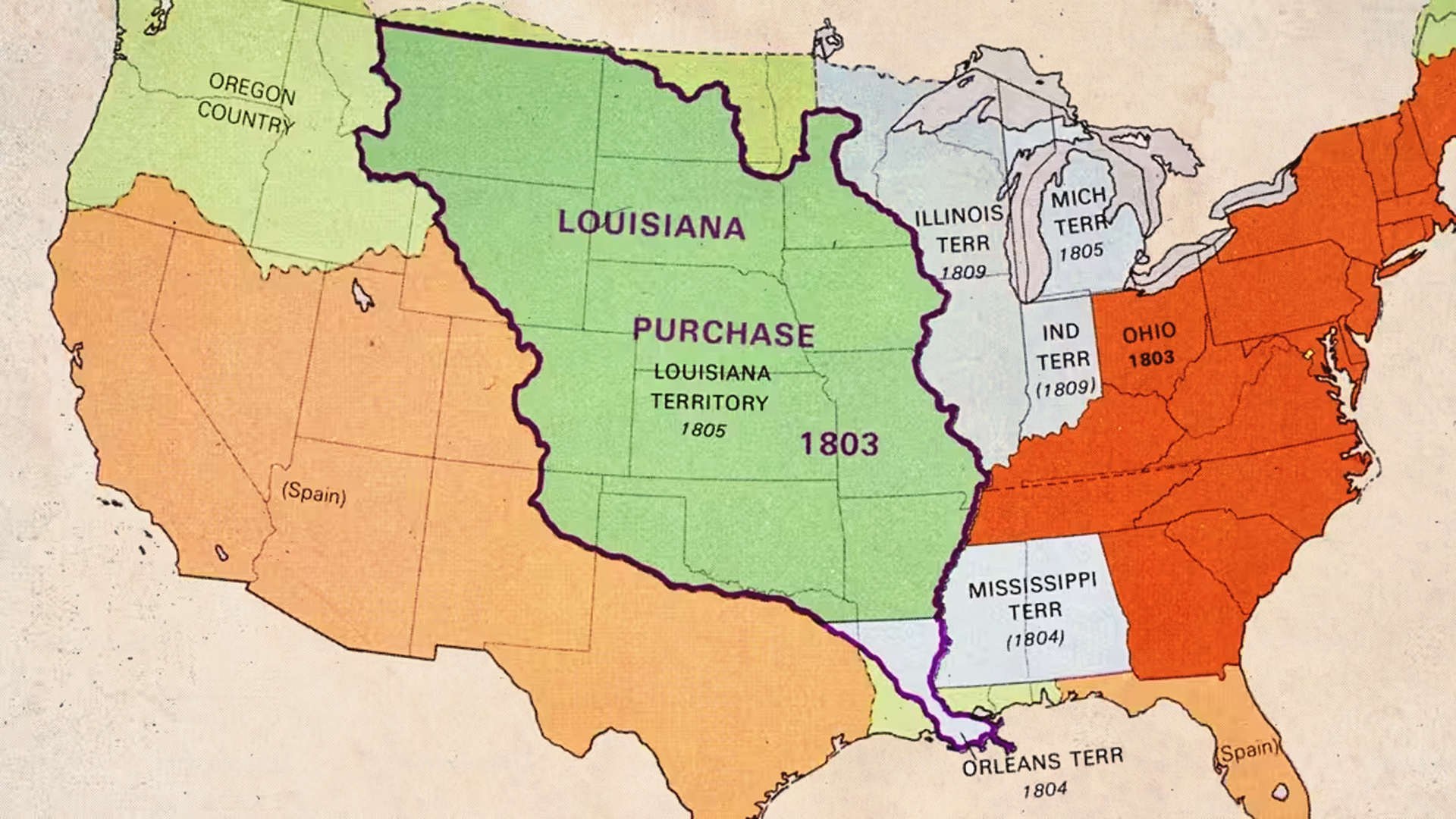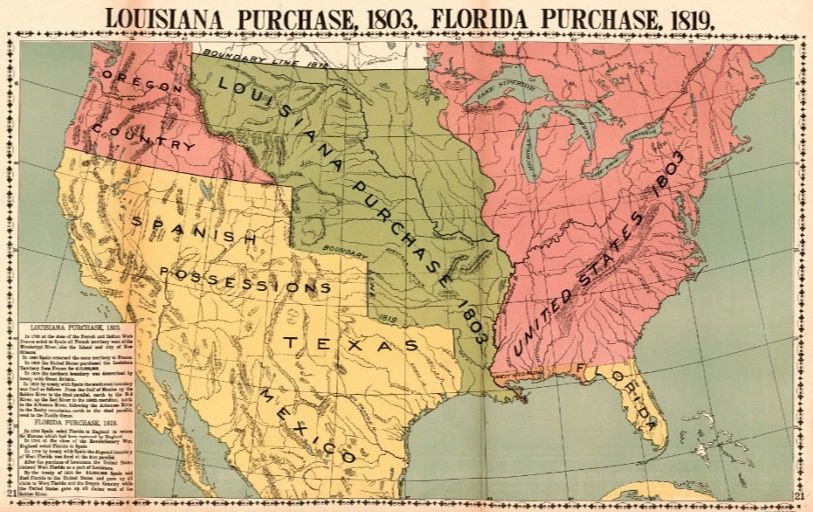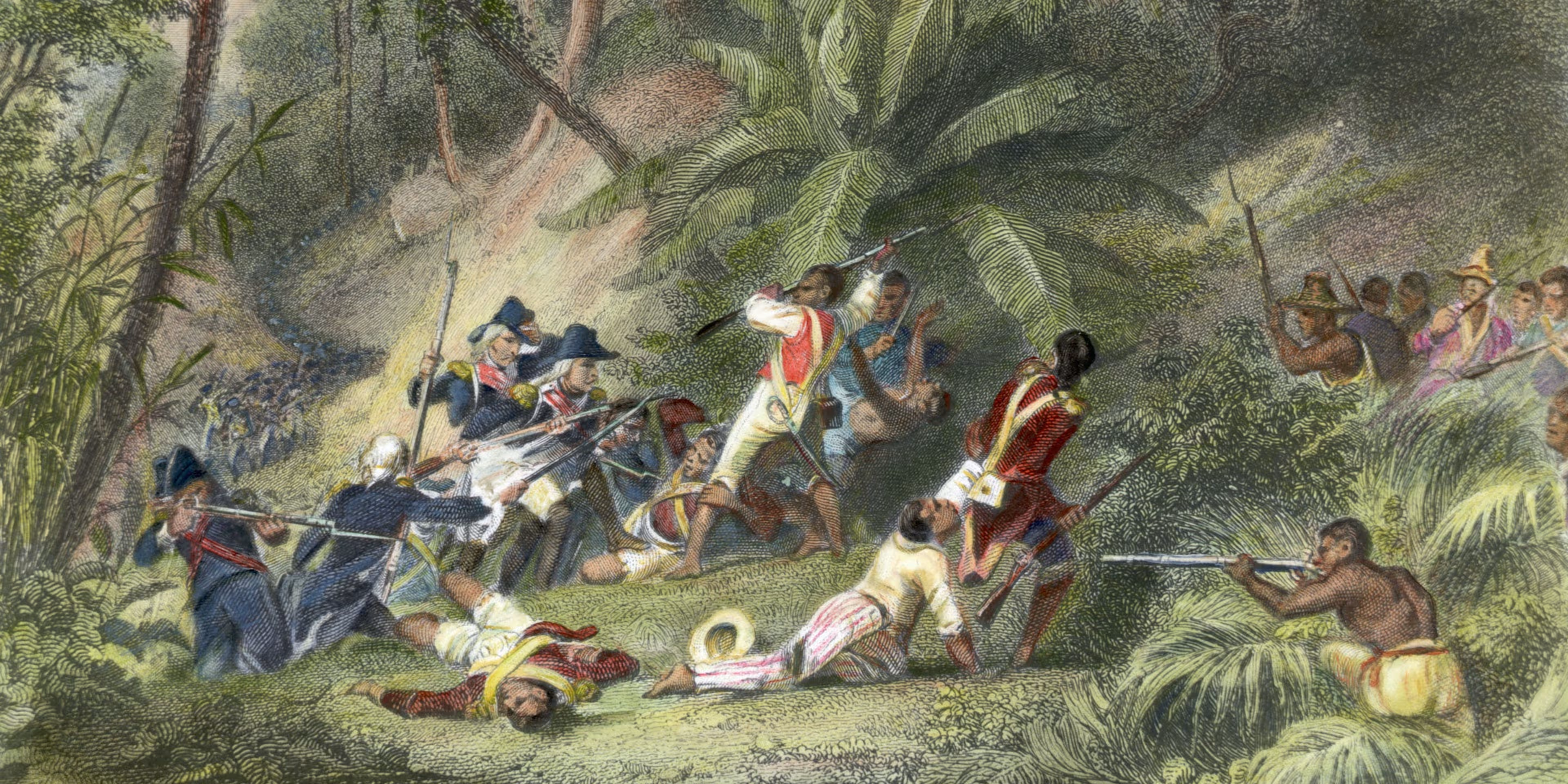The U.S. Senate Ratifies the Louisiana Purchase

Map of the Louisiana Territory in 1803, showing land acquired from France.
What Happened?
At the start of the 1800s, most Americans lived east of the Mississippi River. The lands beyond were home to dozens of Indigenous nations who had lived there for generations, as well as a few scattered European settlements. France had once claimed this massive region, named Louisiana after King Louis XIV, but lost it to Spain after the French and Indian War. When Spain secretly returned the territory to France in 1801, American leaders grew nervous. Napoleon Bonaparte, France’s ambitious ruler, was far more powerful than Spain, and his control of the Mississippi River could threaten U.S. trade.
The Mississippi River was vital to farmers and merchants in the West, who used it to ship crops down to the port of New Orleans. When Spanish officials—acting under French direction—suddenly cut off American access to New Orleans in 1802, panic spread through the young republic. Without the right to store and ship goods there, the economy of the western frontier would collapse. President Thomas Jefferson, usually cautious about big government moves, decided the United States had to act fast.
Jefferson sent American diplomats Robert Livingston and James Monroe to France to negotiate the purchase of New Orleans and a few nearby lands for up to $10 million. But when they arrived, they were stunned by France’s counteroffer. Facing war with Great Britain and needing money to fund it, Napoleon offered to sell not just New Orleans, but the entire Louisiana Territory for $15 million, less than three cents an acre. The American envoys immediately accepted, even though this exceeded their official instructions.
France’s surprising decision to sell was shaped by events far beyond Louisiana. In its Caribbean colony of St. Domingue (today’s Haiti) a massive slave rebellion had overthrown French control. Enslaved people, inspired by the ideals of liberty and equality from the French Revolution, rose up against their oppressors in 1791 and ultimately defeated Napoleon’s troops. The rebellion destroyed France’s dream of rebuilding a colonial empire in the Americas. Without Haiti’s sugar wealth to support it, Louisiana became more of a burden than a prize, pushing Napoleon to sell it off to the United States.
When the treaty arrived in Washington, Jefferson faced a constitutional dilemma. The U.S. Constitution didn’t explicitly give presidents the power to buy land from foreign nations. Jefferson, a strict interpreter of the Constitution, worried about setting a risky precedent. But the opportunity was too great to lose. He reasoned that the president’s power to make treaties included the power to acquire territory. As he quietly told an advisor, 'The less we say about constitutional difficulties the better.'
The Senate ratified the Louisiana Purchase Treaty on October 20, 1803, by a vote of 24 to 7. The purchase doubled the size of the nation overnight, adding land that would eventually become parts of 15 states—from Louisiana and Arkansas to Montana and the Dakotas. It secured control of the Mississippi River and New Orleans, ensuring America’s economic independence from European powers.
However, the purchase also carried a painful contradiction. The same rebellion that freed enslaved people in Haiti helped make the deal possible, but the new territory soon expanded slavery within the United States. As settlers moved west, lawmakers debated which parts of the Louisiana Territory would allow slavery, a conflict that led to the Missouri Compromise of 1820. By the mid-1800s, slavery had grown even deeper roots in areas opened by the purchase, setting the stage for the national tensions that would erupt in the Civil War.
For Native American nations, the Louisiana Purchase marked the beginning of immense upheaval. The U.S. viewed the new territory as 'empty' land ready for settlement, ignoring the people who already lived there. The Louisiana Purchase thus planted both the seeds of growth and of future conflict over land, sovereignty, and westward expansion.
The Louisiana Purchase demonstrated how diplomacy, timing, and bold decision, making could reshape history. It showed the young United States learning to act on the world stage, balancing law and ambition, ideals and opportunity. For better and for worse, the purchase set the nation on a path toward becoming a continental power, expanding both freedom and oppression in its wake.
Why It Matters
The Louisiana Purchase wasn’t just a real estate deal, it was a turning point in U.S. history. It doubled the country’s size, secured control of vital trade routes, and began the westward expansion that would define America’s future. It also raised lasting questions about power, democracy, and the rights of Indigenous peoples whose lands were now claimed by others. The purchase taught America that opportunity often comes with responsibility—and that great achievements can carry complex legacies.
?
Why did Napoleon decide to sell all of Louisiana instead of just New Orleans?
How did the Louisiana Purchase challenge Thomas Jefferson’s beliefs about the Constitution?
What did the Louisiana Purchase mean for Indigenous peoples living in the territory?
Why was control of the Mississippi River so important to the United States?
How did the Louisiana Purchase influence America’s sense of identity and destiny?
Dig Deeper
How Jefferson’s bold move doubled the nation’s size and reshaped its future.
The surprising story of how Jefferson’s plan to buy a port became a continental transformation.
Related

The Louisiana Purchase: A River, A Bargain, and a Bigger United States
In 1803 the United States bought the vast Louisiana Territory from France, doubling the nation’s size, securing the Mississippi River, and setting the stage for westward expansion and hard questions about slavery and Native sovereignty.

Thomas Jefferson’s Balancing Act: Power, Principles, and Pirates
He wanted smaller government. He ended up doubling the country. Jefferson’s presidency is the story of a man trying to shrink power—and finding out how complicated that gets when the world comes knocking.

American Revolutionary War: From Protest to a New Nation
How arguments over taxes and rights grew into an eight-year war—and how ideas, allies, and perseverance turned thirteen colonies into the United States.
Further Reading
Stay curious!

